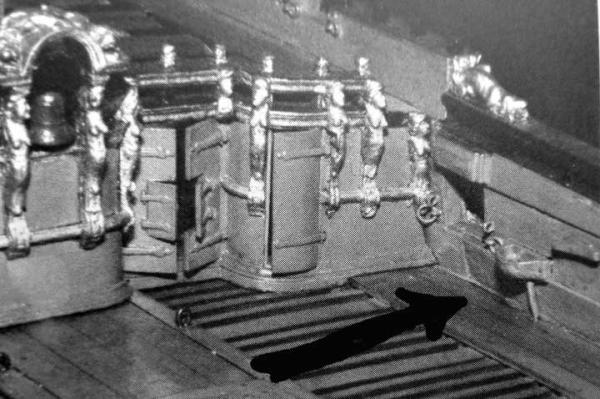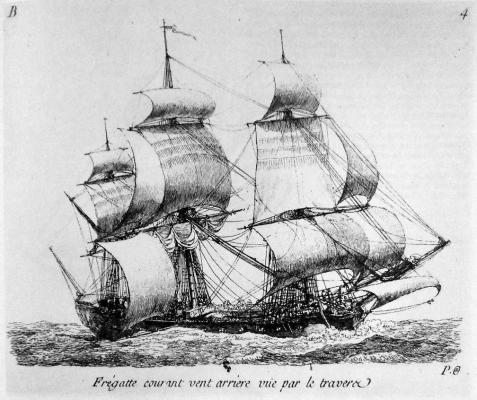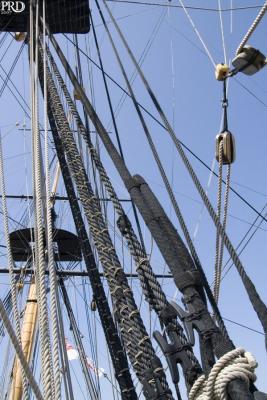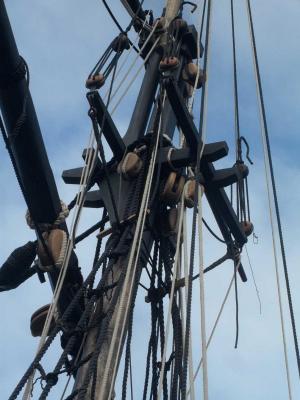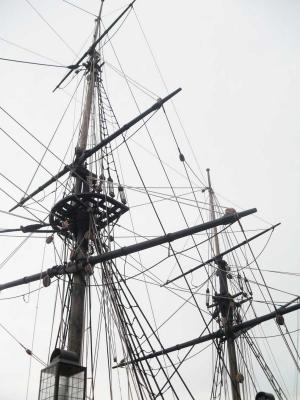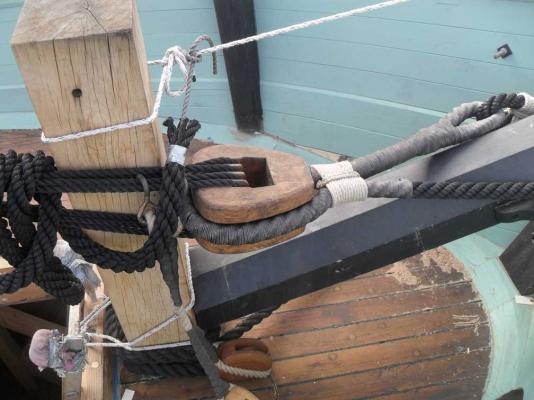
JerseyCity Frankie
Members-
Posts
1,338 -
Joined
-
Last visited
Content Type
Profiles
Forums
Gallery
Events
Everything posted by JerseyCity Frankie
-
Color of line gets debated a bit but its safe to say the shrouds should be black or very dark brown. In fact all standing rigging will be black or very dark in color since on the real ships they were repeatedly painted with pine tar, which was used to keep water from penetrating the rope fibers and causing rot. The ratlines ( the horizontal foot ropes the sailors tread upon to ascend) are also dark in color but there is some debate about weather or not they were just as dark as the shrouds, some modelers leave them "natural" colored. I tend to think they were slightly lighter but still darker than the running rigging.As for the "bindings" you mention I assume you mean the lashing holding stuff together. This would be dark too but I like to use it as an opportunity, on the model, of introducing some variation of color and I use a different shade-slightly lighter or slightly darker than whatever it will be viewed against but not too contrasting- to suggest a different material in use and to allow it to catch the eye.
-
Rigging ropes right handed or left handed?
JerseyCity Frankie replied to md1400cs's topic in Masting, rigging and sails
My view is that Its the sort of thing nobody will ever notice on a ship until their attention is called to it. However once you use some yourself you will appreciate its use on other models, you will recognize it, I suppose, as the mark of someone who went the extra mile for authenticity. But actually recognizing it is still difficult even when you know the difference. Larger rope aboard ship and anchor cables were often twisted up from three right hand laid ropes into left hand line, so it would not be unusual to find it aboard ship in various uses. -
The only consequence of using 24"would be if you KNOW the sail you are modeling has, say, EXACTLY 40 full width cloths in it at a given dimension. Now if you make 40 cloths that are each 24" wide you wont have the proper number of cloths in the sail. Or you could be left wondering if the person who drew up the plans took the same 24" shortcut.
-
I love cutters. I'm so glad you opted to include the sails. As you say, they take a lot of time and effort. But the difference between a cutter model with one tall mast and no sails set, and a cutter with all that area above the deck defined and outlined by an acre of canvas , is remarkable. Also I would bet that the model with the sails set will not have its long thin bowsprit broken off one day by an accidental swipe of a careless hand since its white solidity defines the outline of the model.
- 19 replies
-
- le renard
- artesania latina
-
(and 1 more)
Tagged with:
-
On page 115 of John Franklin's Navy Board Models there is a photo of the fo'castle bulkhead of the 80 gun Boyne of 1692 showing what the author terms the "Pi** Dale. And on page 122 he includes a line drawing of another example from an unidentified First Rate ship of 90 guns from 1702. Each model is in the National Maritime Museum in the U.K. I have not seen the subject touched upon anywhere else. Thanks Dafi for providing more excellent content. If you had your own show I would watch every episode.
-
Naval History On This Day, Any Nation
JerseyCity Frankie replied to Kevin's topic in Nautical/Naval History
..."August 4th,1790-Congress authorized the Secretary of the Treasury Alexander Hamilton's proposal to build ten cutters to protect the new nation's revenue (Stat. L. 145, 175). Alternately known as the system of cutters, Revenue Service, and Revenue-Marine this service would officially be named the Revenue Cutter Service (12 Stat. L., 639) in 1863. The cutters were placed under the control of the Treasury Department. This date marks the officially recognized birthday of the Coast Guard.".... From this website: http://www.uscg.mil/history/Chron/Chronology_Aug.asp -
For some time now I have been fascinated with this engraving of a French Frigate. Its contemporary I suppose and has a lot of fascinating details. Studdingsails set wing and wing! Until I had seen this image I never would have guessed it was possible to set the main course studding sails WITHOUT setting the main course sail. All that canvas set but no Royals. The main topsail has blanketed the fore topsail, the main t’galent has been partially lowered- I wonder why? To allow the fore t’galent to draw better? Look how close to the waves the Main course studdingsail is, if it touches it would surly break something.
-
My understanding is that its the traces of acid in the oil from your skin that causes the discoloration, not heat and humidity. Presumably if you only handle the hull while wearing gloves, it will remain shiny longer. But there are pollutants in the air itself that will eventual discolor the copper.
-
If they are old they are likely made of Lignum Vitae, the hardest known wood. Now considered an endangered species of tree and I think its been replaced with other materials for that reason. If they are Lignum Vitae they should sink in water due to the woods amazing density.
-
Its probably a metal shackle in my opinion. The standing end of the Peak Halyard would have an eye spliced into it (probably with a metal thimble within the eye) and this is schackled to the end of the gaff. The gaff would have to have an iron band at its end at the point where the line terminates in your plan, and this band would have an eye. The shackle would connect the halyard to the spar at this point. Have you got another drawing of the gaff showing a band at that point? Incidentally if there is a shackle here, there will likely be shackles all over the rig, wherever blocks are attached or where other lines originate in the rig. I agree with the guy above that there is no common knot called a "shackle".
-
There is an excellent 1/72 scale model of the Ohio at the Brooklyn Navy Yard Museum. I have seen it and it is of the highest quality, a better model could not be hoped for. The museum is a gem and also happens to feature two world class models by Dan Pariser, who is an active member of this website. Dan's models are of the U.S.S. Monitor and the U.S.S. Main, also in 1/72nd scale, and they are worth the trip to the museum by themselves. The Museum is in the actual Navy Yard and is free. Here is a link with photos and information about the Ohio model at the museum: http://www.navyhistory.org/2011/10/uss-ohio-model-at-brooklyn-navy-yard-center-at-building-92/
-
Nice Morgan build, keep up the good work. Recently I casually looked through the build logs looking for Morgan models and unless I'm mistaken ( which I could be, I didn't scour the archives that hard) I only see one other Morgan model, one built by one of the moderators in 1980. I wonder why there are so few, given that she is still in existence and well documented. Not to mention the fact that she is due to be relaunched in two weeks, her hull fully restored and anticipating a full sailable rig too. So just two Morgans. There must be two dozen Victories and many Cutty Sarks. I wonder why the Morgan has been given less attention? I also wanted to mention the book The Yankee Whaler by Clifford W Ashley, or Ashley Book of Knots fame. I am currently reading it. Ashley sailed as crew on a whaling barque and his book gives an excellent perspective of life on a traditional wooden whaling ship. He covers the history and the techniques and goes into detail on the equipment and the rig. There is a great deal he has to say about the whale boats. His understanding of the subject and his warm personal yet precise writing style makes it a good read. Full of illustrations which include black and white reproductions of dozens of his whaling paintings ( he was also a good artist) and in addition many of his pen and ink sketches which will be familiar to any lovers of his famous book of knots.
- 2,250 replies
-
- model shipways
- Charles W Morgan
-
(and 1 more)
Tagged with:
-
cleats
JerseyCity Frankie replied to ross's topic in Discussion for a Ship's Deck Furniture, Guns, boats and other Fittings
Cleats and belaying pins on models are so often out of scale. Note the thickness of the shroud in relation to the cleat in the excellent photo Jim Lad provided. Here is a shot of cleats on H.M.S. Victory with no coil hung that is also instructive, I found it on this website http://www.prdobson.com/album/hms-victory/photo/134/ Not so obvious is that the cleats on shrouds should have their inner face grooved to sit tight up against the cylindrical shape of the shroud. -
I'm in awe of this project. I think everyone who starts building ship models will, within a year or two of getting into the hobby, consider the notion of building a huge 1/48 scale H.M.S. Victory. Very few people have the determination and will to start and cary through such a project! My hat is off to you. I am jealous on one level but on another level I am glad it is not me! It takes a special kind of person to do what you are doing.
-
I have no idea who did the research for the Rattlesnake model, it would be interesting to hear what steps are taken to turn research material into a ship model kit.
- 974 replies
-
- rattlesnake
- mamoli
-
(and 1 more)
Tagged with:
-
Here are three shots of rigging details from the ship Eleanor. They were taken while the uprig was underway so not all the lines are rigged and there are a lot of Irish Pennants but the photos should give an idea of the texture of things. The shot of the Heart is odd since the Samson post for the windlass has not been cut to its final size and looks out of place but the photo of the stay and the heart looked like a good detail. Work on the ship was at a frantic pace to meet deadline so everything was going together at once. Note the sawdust. The Post would be unrecognizable the following week as it became part of the Windlass and belfry assembly. The overall shot of the rig is very high contrast so its hard to make out details but I hope it can be useful. An ironic twist on this story is that after my job working on rigging this real ship ended, I got hired to restore a miniature ship model. The ship model job actually paid better. Still, I love working on an actual ships rig so much I would do it for free and I'm always going to remain very grateful that I got the chance to work on the Boston job.
- 974 replies
-
- rattlesnake
- mamoli
-
(and 1 more)
Tagged with:
-
Hi JSGerson. The Museum suffered a fire at some point in the recent past and a new organization came in and rebuilt it last year, I think the ships are completely new, I know everything above the waterline on them is new at any rate. As to finding photos of the Eleanor online, I think you just have to google it really hard. I will look through my photos and post what shots I have if you would like to see them. The shipwrights on the project were all working through Gloucester Marine Railway (and they were all great people) All the work on the hull took place in Gloucester then the hulls were towed to Boston for the uprig. A local Gloucester paper called Good Morning Gloucester was covering the project, they may have a website with an archive?
- 974 replies
-
- rattlesnake
- mamoli
-
(and 1 more)
Tagged with:
-
Last year I got hired to help rig two full sized museum replica ships at Boston's Tea Party Museum, the Eleanore, a three masted ship and the Badger, a brig. Here is the museum's website. http://www.bostonteapartyship.com/?gclid=CLrYjN-EyLcCFcyf4AodNxgAKA The reason I bring it up here is that we used the rigging plan for the Rattlesnake as the model for the Eleanore's rig, the two vessels spar plan being vary similar. We used traditional methods so the only iron in the whole rig was the hooks on the futtock shrouds, everything else was done with lashings and seizings. Here is the google search result for the ship: http://www.google.com/search?q=tea+party+ship+eleanor&safe=off&hl=en&gbv=2&tbm=isch&spell=1&sa=X&ei=QaGsUdrsHYWO0QHlhYCQAg&ved=0CCoQBSgA
- 974 replies
-
- rattlesnake
- mamoli
-
(and 1 more)
Tagged with:
-
Two English fans loved the books so much, and love cooking too, to the extent that they researched all the meals and foods mentioned in the O'Brian novels and wrote a cookbook! It's called Lobscouse & Spotted Dog and contains instructions and comments on such fair as: Skillygalee, Pig's Fry, Shrewsburry Cakes, Haggis, Turtle Soup, Pig's Trotters, Figgy-Dowdy, Drowned Baby, Dog's Nose, and also of course Lobscouse and Spotted Dog. Here is the recipe for Soused Hogs Face. From the book Lobscouse & Spotted Dog by Anne Chotzinoff Grossman and Lisa Grossman Thomas 1 pig’s head, about 10 pounds, cleaned but not skinned 2 pounds (6 cups) white cornmeal 3 cups white wine 1 cup water 2 bay leaves 1 tablespoon salt 12 peppercorns 1 knob fresh ginger, sliced 1 nutmeg cut in half Place the head in a large bucket with half the cornmeal and cold water. Soak 2 hours or longer. Remove the head from the water, rinse well, and place in a large pot with the remaining cornmeal and water to cover. Bring to a boil, covered, and simmer 3 hours. Remove from pot. When it is just cool enough to handle, pick all meat from the bones. Reserve the tongue and ears. Wring out a cloth in warm water. Put all the meat into the cloth and tie up as tightly as possible. Chill until firm. Combine the wine, vinegar, 1 cup water, and the spices. Untie the cloth and pack the meat into a crock. Add the tongue and ears. Pour the wine mixture over the meat. Weight the meat to keep it submerged. Seal the crock and store in a cool dark place for up to 2 weeks before serving. Serves 6
-
Algay the Trestle trees are attached to the mast, the cross trees go on top of the trestle trees, they are notched so they fit together forming a sturdy flat support. The top is not attached directly to the mast, it is attached to the support created by the crosstrees and trestletrees. The square hole in the Top is called the Lubber's Hole. If you were standing in the Top you could look down at the deck through the Lubber's Hole. The opening of the Lubber's Hole is large enough for the shrouds to come up from the deck, through the Lubber's Hole, between the cross trees and over the trestle trees and around the mast. The shrouds have a loop in their ends big enough to fit over the mast.
-
I am looking forward to using the phrase "softly softly catchy monkey" at the next opportunity even though I am not sure exactly what it means.
About us
Modelshipworld - Advancing Ship Modeling through Research
SSL Secured
Your security is important for us so this Website is SSL-Secured
NRG Mailing Address
Nautical Research Guild
237 South Lincoln Street
Westmont IL, 60559-1917
Model Ship World ® and the MSW logo are Registered Trademarks, and belong to the Nautical Research Guild (United States Patent and Trademark Office: No. 6,929,264 & No. 6,929,274, registered Dec. 20, 2022)
Helpful Links
About the NRG
If you enjoy building ship models that are historically accurate as well as beautiful, then The Nautical Research Guild (NRG) is just right for you.
The Guild is a non-profit educational organization whose mission is to “Advance Ship Modeling Through Research”. We provide support to our members in their efforts to raise the quality of their model ships.
The Nautical Research Guild has published our world-renowned quarterly magazine, The Nautical Research Journal, since 1955. The pages of the Journal are full of articles by accomplished ship modelers who show you how they create those exquisite details on their models, and by maritime historians who show you the correct details to build. The Journal is available in both print and digital editions. Go to the NRG web site (www.thenrg.org) to download a complimentary digital copy of the Journal. The NRG also publishes plan sets, books and compilations of back issues of the Journal and the former Ships in Scale and Model Ship Builder magazines.


